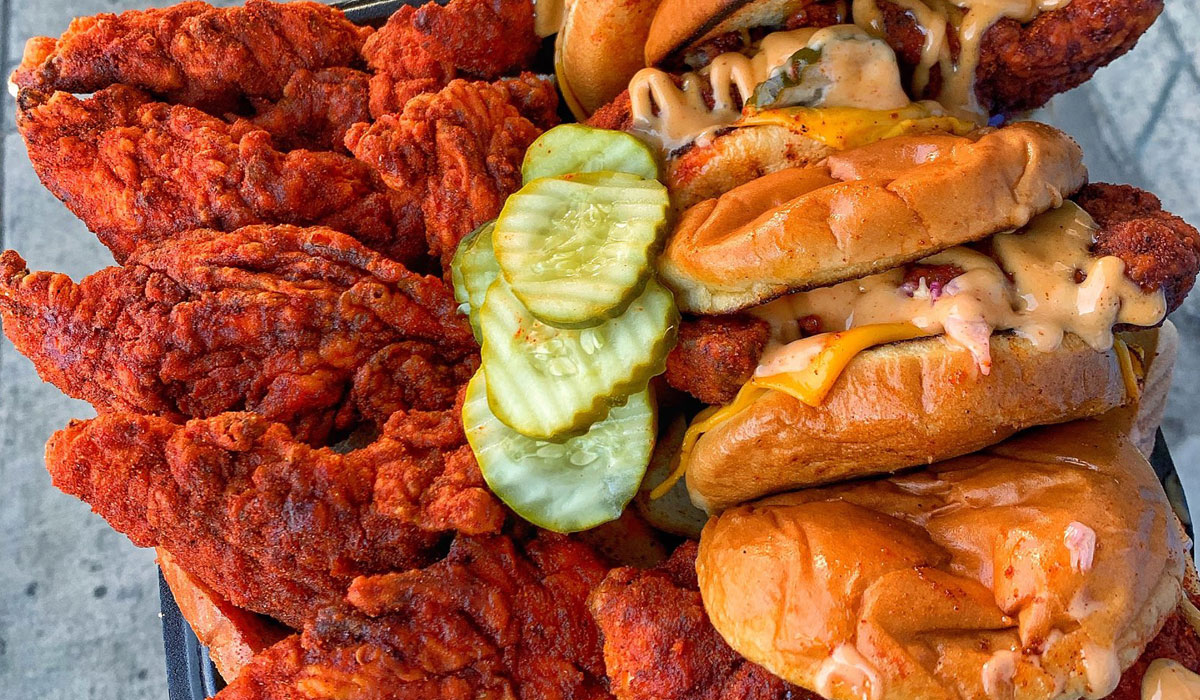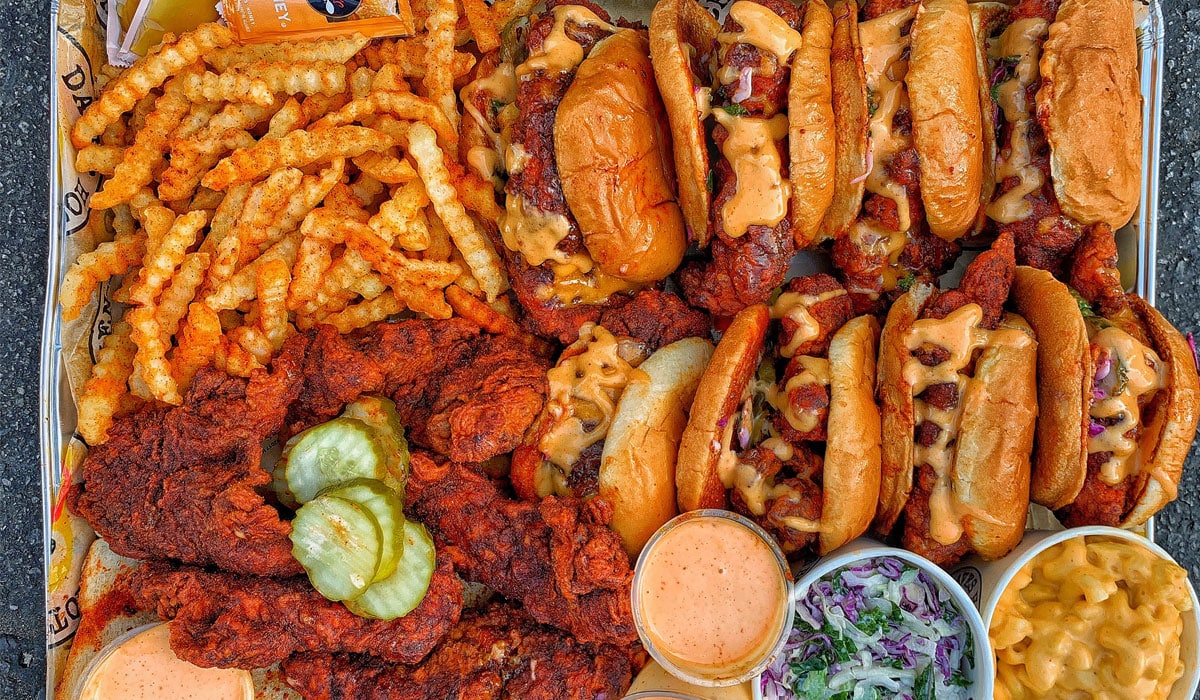When Dave’s Hot Chicken COO and president Jim Bitticks joined the company, he admittedly knew little about the chain’s humble upbringing.
So, like anyone with a cell phone or computer these days, he Youtube’d it. Bitticks found a video from 2017 of two men trying Dave’s Hot Chicken for the first time at the concept’s parking lot pop-up, founded by Arman Oganesyan, Dave Kopushyan, and brothers Tommy and Gary Rubenyan.
“When they bite into the food, I’m not even kidding, one of the guys’ eyes rolled back in his head and he’s like, ‘Oh!’ And there’s all sorts of expletives, and ‘They’re like, oh sh**, that’s so good,’” Bitticks says. “How do we operationalize that? How do we operationalize that ‘rolling in the back of your head’ moment? That’s been the challenge. But I think that’s been our focus. From the very beginning, it’s about the food. Nobody gives a crap about this, that, or the other thing. They care about the food.’”
Oganesyan remembers plenty of moments like those, back when customers would wait in the parking lot for two-and-a-half hours. The environment was nothing special; it was just a tent, a couple of fryers, and some tables. The menu, based around the Nashville hot chicken craze, is what drew crowds. As Oganesyan says, “Food is our superpower.” When the fast casual transitioned to its first brick-and-mortar, the founders had an opportunity to visually invoke the same feelings customers have when they first bite into a tender or slider. At the start, it was decided that every store would look different to prove Dave’s authenticity. From there, “the coolness of Dave’s just evolved,” Oganesyan says.
LOOK BACK: QSR’s Breakout Brand of 2021: Slim Chickens Hits Another Gear
Fueled by a passion for food and sympathy for people who didn’t have access to Nashville hot chicken outside of Southern California, the founders wanted to plant as many flags as possible throughout the U.S. What they had on paper compared to what happened is still difficult for Oganesyan to wrap his mind around.
Thanks to a well-built franchising program, Dave’s finished 2022 with roughly 100 locations—including international spots in Canada and Dubai—after starting 2021 with just seven stores. There are 620 units in development, and 85 restaurants are expected to debut globally in 2023. The company believes there’s room for 1,000–1,200 stores domestically and another 800 to 1,000 internationally.
“To be here now, it’s pretty incredible, but I think we also realize that we still have a lot of work to do. We still have a lot of stores to open,” Oganesyan says. “We have a lot of franchisees. So right now our priority is making sure that our operations and the stores are running really well so franchises continue to want to open up stores. So we understand that we’ve done a lot, and we also understand there’s still a lot to do. We’re still in that work mode—continuously trying to improve the brand as much as we can.”
Bill Phelps, cofounder and previous longtime CEO of Wetzel’s Pretzels, attributes much of the growth to understanding the customer base, which is the 15- to 30-year-old male demographic. That group hasn’t changed much from the early days of the parking lot and the first brick-and-mortar unit in Hollywood. Phelps says no one knows more about capturing that target audience than Oganesyan. The CEO, a former Nestlé marketing man himself, describes Oganesyan as the best marketer he’s ever worked with. That’s because all the video and photographic content on TikTok, Instagram, and other platforms are organic, genuine, and appealing. As the chain’s footprint has remarkably expanded, Yelp and Google scores have increased in the past couple of years, which tells Phelps that Dave’s is doing what’s necessary to maintain a consistent guest experience.
[image source_ID=”132984″]
“Having a company footprint is important to us, as well as leadership having real skin in the game by being franchisees themselves,” Dave’s Hot Chicken COO and president Jim Bitticks says.
Last year, the brand caught the eyes of Grammy-award-winning artist Drake, who loved the food so much he took a minority stake in the company, along with Samuel L. Jackson, NFL Hall-of-Famer Michael Strahan, and Red Sox owner Tom Werner.
“When you’re in the first couple of weeks at the parking lot, cooking food and making 100 bucks a day, if somebody told you you’re going to be partners with Drake in a couple of years, you’re probably not going to believe it,” Oganesyan says. “So it’s definitely surreal and it just validates that everything we’ve done have been the right things. Keeping the brand authentic, keeping it about the food, keeping it about the customer experience. All that paid off enough that one of the biggest people in pop culture invested into the brand. So it was surreal. We were big fans of him. We still are. And like I said, it validated everything we did and it’s still kind of surreal and hard to believe.”
Although Dave’s is headquartered in Southern California, it has locations in multiple states thousands of miles away, like Wisconsin, North Carolina, Ohio, and New York. The intention is to be a national brand, and Bitticks—formerly the chief restaurant officer of Blaze Pizza—came with a playbook. After all, the pizza chain was once called the fastest-growing restaurant chain in U.S. history. PFG is the distributor, so a countrywide network has been lined up. In terms of markets, the critical factor isn’t so much the demographics of a particular city, but more so the quality of the franchisees driving expansion. Operators typically sign on for six to 10 stores, depending on experience.
Dave’s is willing to go anywhere if the operator meets expectations. The chain moved into Tutalatin, Oregon, a suburb of Portland, in an endcap location, and the team was shocked by the sales volume. The brand opened on the same day in Denver, Colorado, but in an urban endcap spot, and sales were just as impressive. The same results happen with standalone locations. The standard real estate footprint is between 2,000 and 2,500 square feet. The smallest is 1,400 square feet and some reach 3,000 to 3,500 square feet.
Ten to 15 percent of the system uses drive-thru, and the brand opened a ghost kitchen in 2021. A pickup-only location is in development.

“Clearly, it gives franchisees confidence that they can invest in this brand, because we opened up in Menomonee Falls and I don’t know about you, I’ve never heard of Menomonee Falls before,” Phelps says with a chuckle. “It’s up near Milwaukee, and we opened it up, and it was great. We opened up into Tualatin, Oregon. I had never heard of Tutalatin, Oregon, before, and we were knocking it out of the park. And again, both of those cases, we had great franchisees that had restaurant experience in the market and picked great real estate. And that’s been our model and that’s going to continue to be our model.”
To support growth, Dave’s built five training teams that are deployed when restaurants open. The chain has opened as many as four stores in one day thus far.
Bitticks believes the chain could release eight groups at once, if necessary. The teams, who feel like “rock stars when they’re presenting and turning on a store in a particular market,” the COO says, copy the feel and vibe of the original location. If performance is slipping at all, Dave’s will send another team to help, but that’s only happened once. Thanks to the franchise model, the brand can fully pass the baton once the operator surpasses three to five stores. These franchisees have training squads and open self-sufficiently as they expand.
Bitticks, Oganesyan, and other Dave’s executives double as franchisees to better understand what they go through on a day-to-day basis. It also proves to operators just how much they believe in the model. In addition to explosive franchise growth, the chain plans to open one to two company-owned restaurants per year.
“It goes along with that same concept of having skin in the game,” Bitticks says. “If we only had franchise restaurants, then franchisees feel like we don’t know their pain. We don’t feel their pain. So having a company footprint is important to us, as well as leadership having real skin in the game by being franchisees themselves.”
More eyes will be on Dave’s going forward. In the fall, the company launched its first national advertising campaign called “Don’t Die Before You Try It,” starting with a couple of dark comedy commercials where customers tell stories of their loved one’s untimely fate through crazy events and lament they didn’t have a chance to try Dave’s food.
The campaign showcases the brand’s desire to focus on what got it here. That starts with the food, followed by the profitability of restaurants.
“The growth will take care of itself if we do those two things, and franchisees will clamor to open their second, third, and fourth locations because it is a really profitable model with very high sales,” Phelps says.
“And so those two things together, we keep the sales going by keeping the chicken amazing. And we keep the growth going by keeping the profitability amazing.





